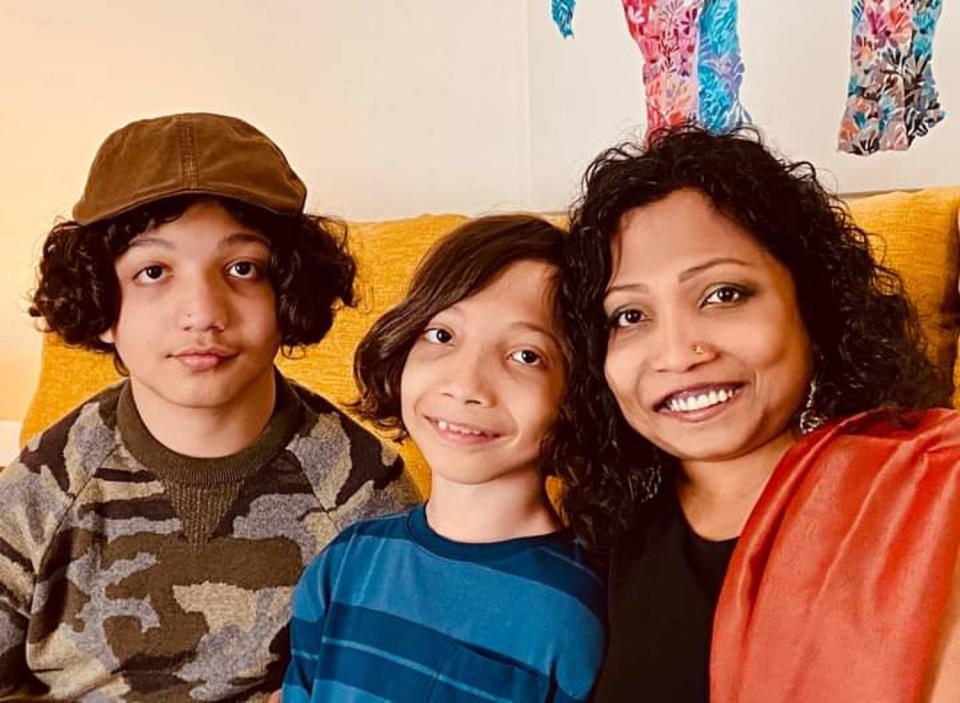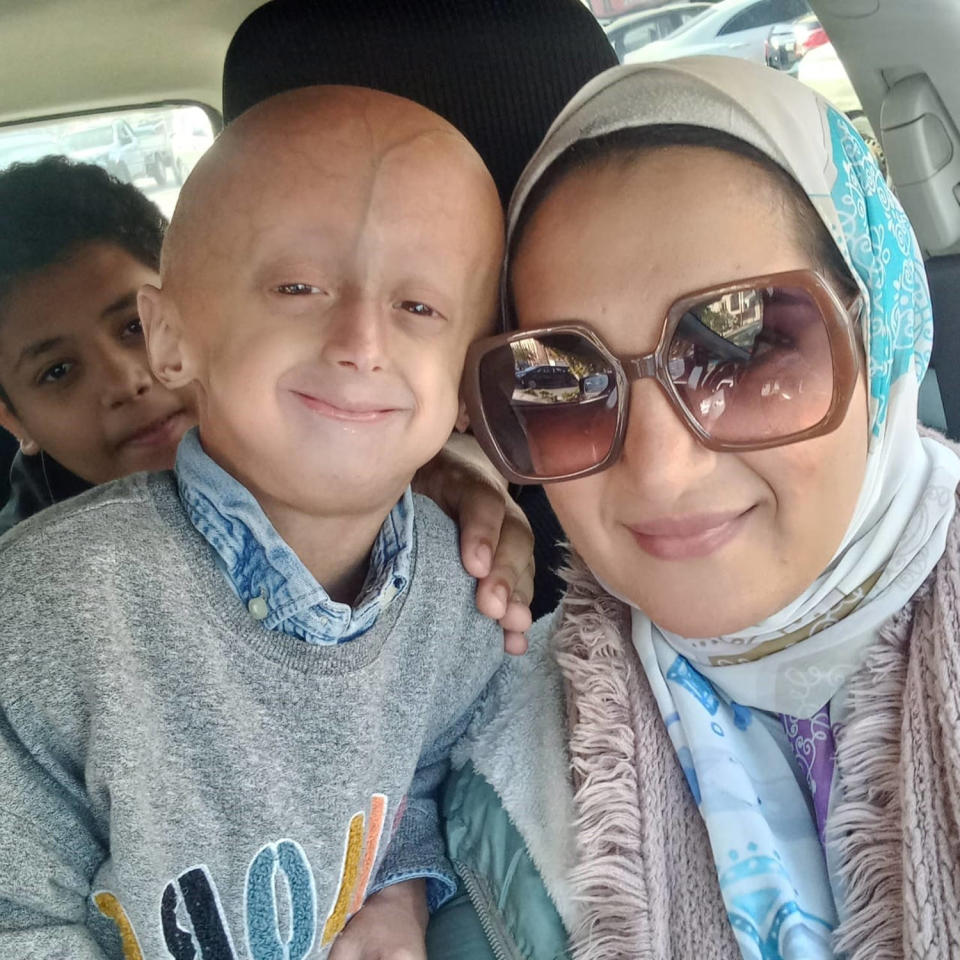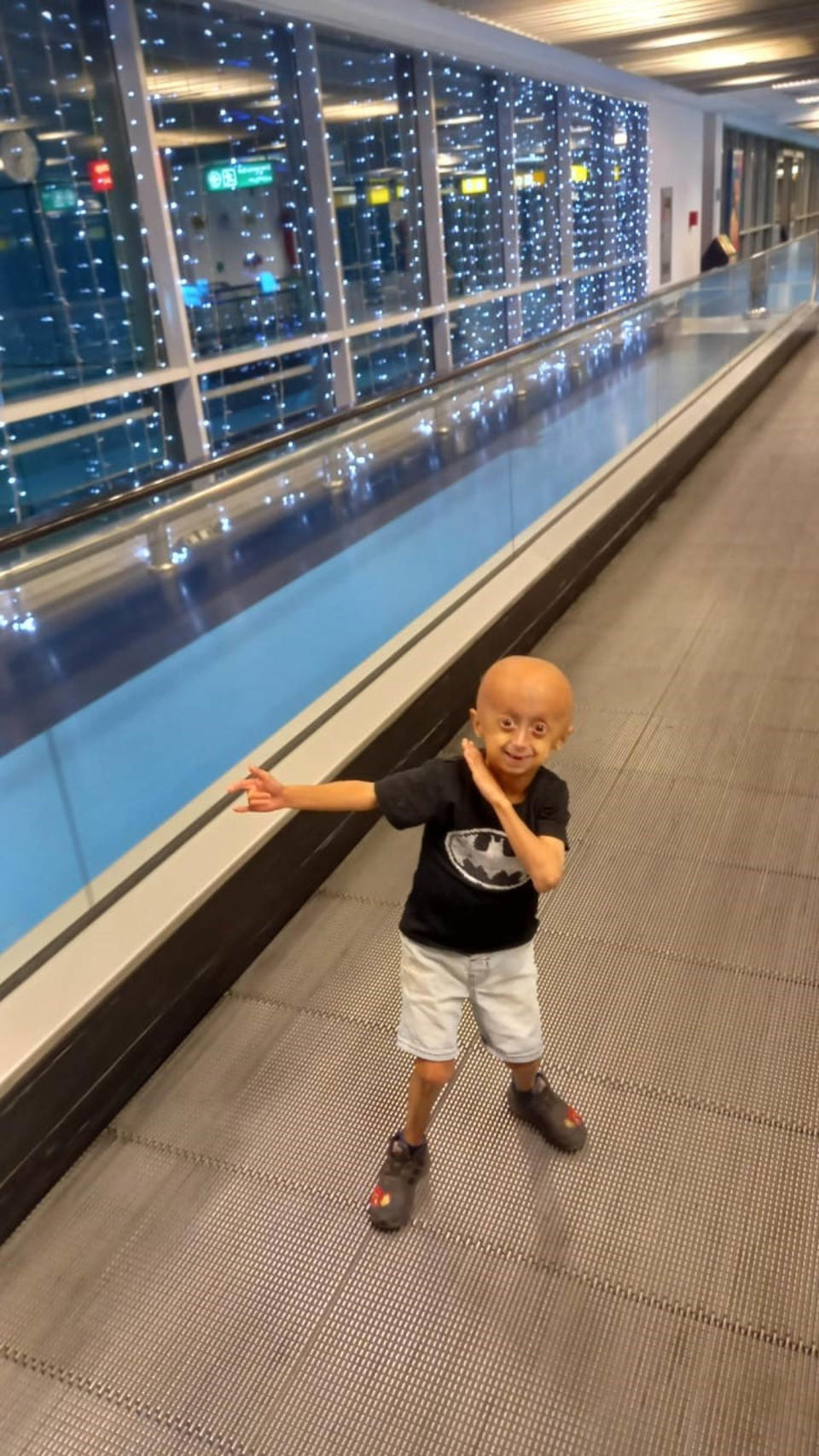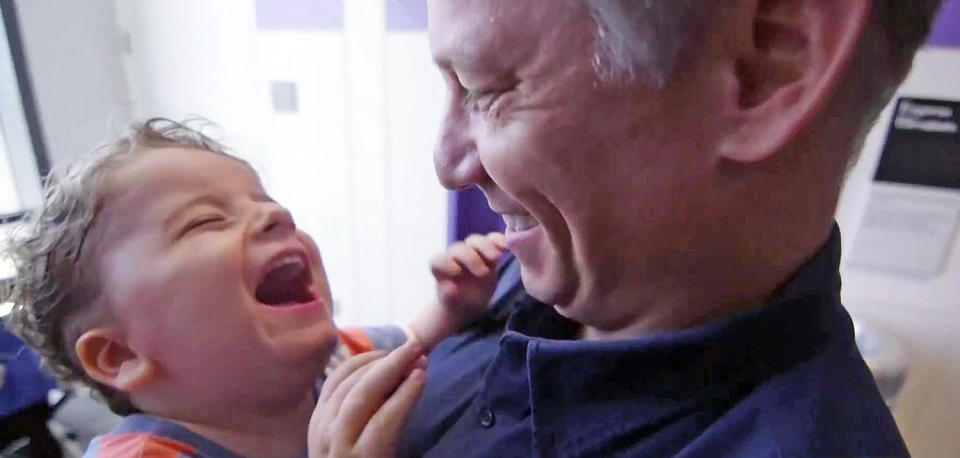NBC's Richard Engel lost his son to a rare disease. He and other parents use research to create a legacy
- Oops!Something went wrong.Please try again later.
For most of her life, Neena Nizar experienced weakened and crooked bones that caused her pain and made walking difficult. But doctors never knew why.
“My parents would really tell doctors, ‘Her bones are bending,’ and they wouldn’t really believe it,” the 46-year-old from Nebraska tells TODAY.com. “I grew up with lots of corrective surgeries and living with a misdiagnosis for most of my life.”
When she was 32, she finally learned what caused her bowed bones — an ultra-rare disease, Jansen Metaphyseal Chondrodysplasia.
“I had almost given up, honestly,” she explains. “The world suddenly made a lot more sense.”
In 2015, Nizar was talking to some researchers about Jansen, which causes swelling and stiffness of joints, high levels of calcium in the blood in addition to bent, fragile bones. At the time, she had identified five patients in the world with it, including herself and her two sons.

Nizar was lobbying for studies on Jansen to find a potential therapy or cure when a researcher said something shocking to her.
“Somebody actually told me, ‘No one is going to care about five patients,’” Nizar says. “They were actually telling me that my life and my kids’ lives didn’t matter.”
Nizar didn't let that discourage her. She will be the first person to undergo treatment in the first-ever clinical trial for Jansen, followed by two other adults enrolled in it. Her sons will participate, too.
“Sometimes it can take a mountain to climb to be able to get to the other side of treatment,” Nizar says. “Our story is really important because it shows that every life has value, and every life is worth fighting for.”
Nizar’s story is not unlike others with rare diseases. The National Institute of Health (NIH) estimates that 7,000 rare diseases impact between 25 to 30 million Americans, but few treatments exist for these diseases. Worldwide, there are 300 million people with rare diseases, according to a paper in the European Journal of Human Genetics.
For some, rare diseases cause disability, chronic illness and pain. For others, a rare disease is fatal. Clinical trials often represent the only hope that people with rare diseases have for a possible treatment.
“We have to learn so much from the trial. But our hope is that there’s a benefit to it,” Nizar says. “My older son, he’s 15, and I have a younger son’s who’s 13. And the reality is that even though we’ve (started this trial) so quickly, as a mom I just feel like it’s not been quick enough.”
Rare disease, research and its treatment
Rare diseases are those that affect fewer than 200,000 people in the U.S., according to the Orphan Drug Act of 1983, which facilitates the development of drugs for rare diseases.
But even within this definition, there's tremendous variation because it can refer to the 100,000 Americans with sickle cell disease or the 30 people worldwide with Jansen. More than half of rare diseases impact children, says Pamela Gavin, chief operating officer of National Organization for Rare Diseases (NORD).
Finding a diagnosis for a rare disease can take anywhere from four to nine years, according to research in PLOS One. But a diagnosis is only the first step in a complicated journey. Some conditions are so rare that most doctors will never encounter them, and most lack treatments.
Many people recently diagnosed with rare diseases don’t know where to go for help, and NORD serves as a resource for them. It manages a database of about 1,200 rare diseases, hosts patient assistance programs, oversees centers of excellence and helps with research. NORD also connects families with rare diseases to support and advocacy groups and introduces them to experts who can treat their children or enroll them in studies, if they exist.
Rare disease research ranges from patient registries to genomic investigations to natural history studies, where patients simply share their experience because some conditions are so rare that it's not known how they progress. And of course, there's clinical trials.
“We’ve never had as many clinical trials ... since the Orphan Drug Act was passed and NORD was formed as we do today,” Gavin tells TODAY.com.
But “more than 95% (of rare diseases) don’t have a treatment or cure," she adds. "So, despite that great activity we still have a long, long way to go." Of the 7,000 identified rare diseases, only 500 of them have an approved treatment, per the NIH.
The Stewart family of Knoxville, Tennessee, enrolled their daughter daughter, Mary Mitchell, in a clinical trial because her rare disease, Sanfilippo syndrome, has no treatment or cure. The degenerative condition, also known as childhood Alzheimer's, robs children of their ability to speak, and progressively they stop walking, sitting up and eating. Most children die before they become teenagers.
"Their quality of life is just nonexistent,” Mary Mitchell’s mom Sarah Stewart, 41, tells TODAY.com. “There was just a short period of time in her short little life where she was cognitively aware.”
Mary Mitchell, who had the nickname Shug and loved Dolly Parton, passed away in 2020 at age 5. When her parents enrolled her in the trial, they knew this outcome was a possibility, but they still chose to do so because they hoped it could give them a few more good years with their daughter. “There was no medical treatment, and this was the one shot we had,” Stewart says.
With some rare diseases, there are only a few doctors considered experts in it, and being connected to them often requires travel, an expense that can be a burden to many. A study in Orphanet Journal of Rare Disease found people with rare diseases spend three to five times as much for health care costs compared to other patients.
Nizar paid to move her family from Dubai to the United States after finding an expert at Massachusetts General Hospital, Dr. Harald Jueppner, who researches bone and nerve isolation and was studying Jansen — though he'd never met a patient with it.
After Jueppner told Nizar there was little funding for his work, Nazir started a foundation to help support Jansen research, which Gavin says is a surprisingly common course of action among parents of kids with rare diseases.
“They weren’t medical experts. They weren’t researchers. They’re not scientists, but they’re facing an unbelievable problem,” she adds.
“I was determined that the only way to help these children have a different future would be to create (a potential treatment),” Nazir explains. “Now that I was a mom, I was driven to find answers. It takes on a whole new level of investigation because you’re now determined that you’ve got to find the answer.”
Research offers hope but comes with risks
For families of children with rare diseases that already have clinical trials, they have to weigh the risks and benefits of participating.
For example, some clinical trials involve a control and experimental group. The control group generally maintains the care they’re receiving without getting the experimental treatment.
“That’s a really difficult decision for a parent to make — to have their child participate in a clinical trial knowing they may be getting a placebo,” Gavin says.
Other barriers include parents not having enough paid time off work to travel with their child to participate in the research. And some children might already undergo hours of therapies weekly and can't spend extra time to be involved research.
If a family does join a clinical trial, they often feel a mixture of excitement and fear about participating.
“There’s definitely a higher level of risk that people can tolerate and will tolerate when it comes to rare diseases,” Gavin says.
“When you participate in research, you’re a guinea pig,” Stewart adds. “They don’t know what’s going to happen.”

After Zein Elsharqawy was diagnosed as an infant with progeria — which causes children to age rapidly and has an average life expectancy of 15 — his mother, Dina Agami, found a clinical trial in the U.S. that could treat some of his symptoms. At first, her family balked at enrolling Zein, now 6, in the research.
“They said, ‘No. How can you do this? It’s the first time (anyone is taking) a medication. It’s a clinical trial. It’s too dangerous,” the mom from Cairo tells TODAY.com. “I said, ‘No. I want to do this clinical trial.’”
So Zein and his mom traveled to Boston to participate. Shortly after, they were able to get the medication shipped home to Egypt. Agami hasn’t seen much of a difference in her already outgoing and boisterous child (who's a social media star), but thinks that it is possible she’ll notice more changes as he ages.
Regardless, she stands by her decision: “(We) must participate in this clinical trial to find a cure,” she says. “It was the only hope.”

‘Don’t give up hope’
Families often feel that participating in research, even if it doesn’t help their child, feels meaningful, Gavin says.
NBC News Chief Foreign Correspondent Richard Engel's son Henry died in 2022 at age 6 after being diagnosed with Rett syndrome, a progressive rare disease that predominately impacts females. But Henry is still helping with the research.
He never walked or talked, and had low muscle tone. Missing several milestones leading up to his first birthday was the first clue that something was wrong.

“He could initially sit up himself, and he could use his hands,” Engel explains. “He wasn’t progressing, and we were getting more and more nervous.”
When Engel first learned of his son's condition, he used his journalism skills to search for help.
“I called every single person I could think of,” he tells TODAY.com.” I called professors at universities. I called every person who I thought would know more about this because I never even heard of this syndrome before.”
The family found Dr. Huda Zoghbi, founding director at the Jan and Dan Duncan Neurological Research Institute at Texas Children’s Hospital. At first, Engel says Zoghbi felt tentative about working with Henry because she wasn't sure he fit into the research.
But she re-ran some tests and examined his genome and found that Henry had a unique mutation that could possibly lead to a better understanding of Rett syndrome. Allowing Henry to participate in research felt like a no-brainer for the family.
“First priority, bar none, is to help your own child,” Engel says. “When you’re there and you’re watching your child deteriorate and suffer in any way, you want that treatment ... immediately to alleviate, in this case, Henry’s pain and improve his quality of life. But you, of course, want to help other people.”
While Henry never talked, he was able to tell his parents when he was happy using various sounds and made-up words. He was often joyful and loved music and food. When home from assignments, Engel, who enjoys cooking, turned gourmet meals into soft foods that Henry could eat, such as meatballs or vegetable purees.
“It was a way for me to connect," he recalls. “It was made with love.”
Henry's death “chipped away” at Engel’s armor, he says. “It was very difficult as his condition worsened. He couldn’t eat anymore, struggle to breathe toward the end. It was tough on us, but nothing like it was on him.”
Engel says his family wanted to share Henry’s life so people know him and to give other families with rare diseases hope.
“We’re still participating in this research even though our son passed away, and that still adds meaning to his life,” Engel says. “I want to tell these other families: Don’t give up hope in our son. We’re working for you. This little boy is working for you.”
It's a common mentality among those who've suffered and sacrificed to put involve a child in research for a rare disease.
“Even if it doesn’t result in something in their lifetime or before irreversible damage, (they know) that they’re contributing to something greater,” Gavin says.
This article was originally published on TODAY.com

